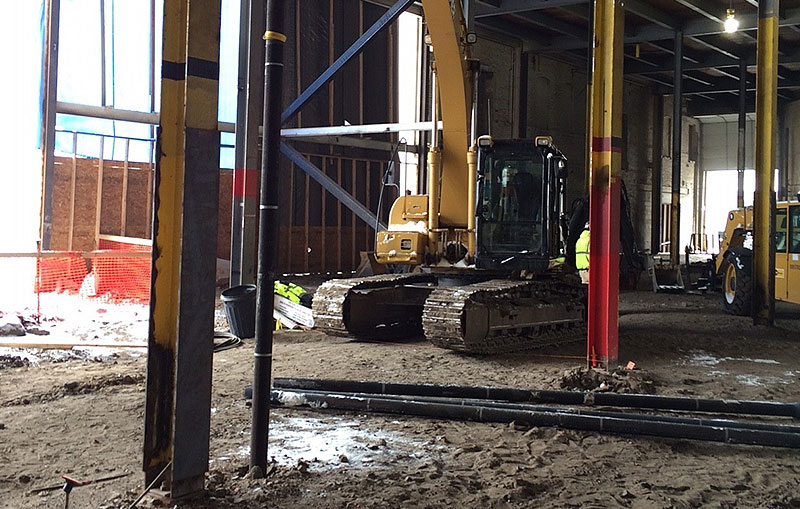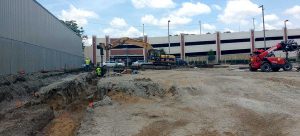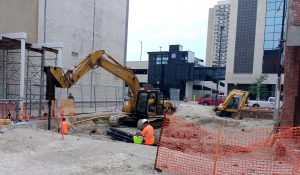Ductile Iron Piles Mitigate Vibration, Access and Overhead Clearance Issues for Deep Foundations

Brendan Fitzpatrick, P.E., Director of Engineering with DuroTerra, LLC in Boston, discusses three primary challenges that Ductile Iron Piles can solve in new construction or renovation projects.
Recently, Ground Improvement Engineering interviewed our partner, DuroTerra, LLC, to discuss the features and benefits of their Ductile Iron Pile products. They are a reliable, cost-effective alternative to conventional pile systems, including helical piles, micropiles and often other more traditional systems like driven piles, augercast piles and drilled shafts. We have used this product with Ground Improvement Engineering on dozens of projects throughout the Midwest for the reasons that this article outlines.

This parking garage project was a Geopier Impact® job where the vibration levels were too high as ground improvement construction approached an existing adjacent building. The Ductile Iron Piles were used along this one building line near the existing building to provide a low vibration foundation support alternative in place of the ground improvement option. Ground improvement was used elsewhere on the site to allow the use of conventional shallow foundations.
What are Ductile Iron Piles?
Ductile Iron Piles are one of the many deep foundation tools available for foundation support when contractors and engineers are looking for effective and efficient approaches to deep foundations and settlement issues. They can be installed in combination with Geopier® ground improvement systems because the equipment needed for this particular product is very similar. Eliminating the need to bring in different or larger equipment can make it a cost-effective option.
Manufactured in 16.4-foot (5m) sections, each DuroTerra Ductile Iron Pile has a tapered end and a reinforced belled end. As each pile is installed, the tapered ends seat into the belled ends for strength and durability. This Plug-and-Drive connection allows the modular system to require minimal laydown area on-site, yet can be installed to depths easily exceeding 100 feet. The system can be used as an end-bearing pile terminating on very dense ground (till) or bedrock.
Alternatively, the system can be installed with an oversized 7- to 12-inch-diameter grout end cap and driven while continuously pumping grout through the center of the pile. This creates a highly efficient friction pile that achieves high grout-to-ground bonding within the soil similar to a micropile, but much faster and less expensive.
While this system is a displacement system and you can get enhancements to the existing soils, it is installed in combination with pile caps and structural slabs similar to other driven pile systems. Here are three reasons that Ductile Iron Piles could be the right solution for your project.
Minimizing Vibration
Ductile Iron Piles can be a good solution when the project is challenged by vibration tolerances due to interior work, adjacent structures and tight sites. The high-frequency driving process results in vibration levels often well below standard levels of 2 inches per second; we typically see vibration levels of one-half to 1-inch per second with this system.
The vibration control feature can be very attractive for urban projects such as multi-family or office sites as well as industrial and agricultural facilities.

This small, 4,000-square-foot project was on a very tight site. The bearing layer (till/rock) at the site was 60 to 80 feet below grade. The original solution was to use augercast piles, but the site was so small that it would be difficult for access and to penetrate to the depths to encounter till and rock. Instead, the team selected 50-ton capacity Ductile Iron Piles.
Managing Low Overhead Structures
There are situations on some job sites where accessibility is limited. We may encounter low overhead clearance where equipment for augercast or driven pile systems can’t operate.
On a project in Iowa, for example, ceiling heights for a manufacturing facility renovation only provided 20-foot to 35-foot clearances. This access is adequate for an excavator used to install the relatively short sections of Ductile Iron Piles, but it would have been too tight for drilled piles and their equipment or driven steel piles. The accessibility factor and acceptable vibration levels have made Ductile Iron Piles an effective foundation solution for several renovations at this growing enterprise.
Solving “Deep” Foundation Challenges
A third major benefit of Ductile Iron Piles is depth. Many projects have poor soil conditions that extend to depths of 50 or 100 feet or more and require piles to terminate below those depths. The Ductile Iron Pile system with the Plug-and-Drive connection can rapidly be installed to meet those depth requirements. In some cases, the system has been used for up to 200-foot depths. Foundation loads are transferred through the pile system to a stronger bearing level of soil (till) or bedrock.
To learn more about Ductile Iron Piles, visit DuroTerra’s project feasibility page and contact Ground Improvement Engineering. We can design systems that include Geopier products in combination with Ductile Iron Piles for deeper foundation support.
You may also be interested in this blog post about other Geopier deep foundation alternatives.
